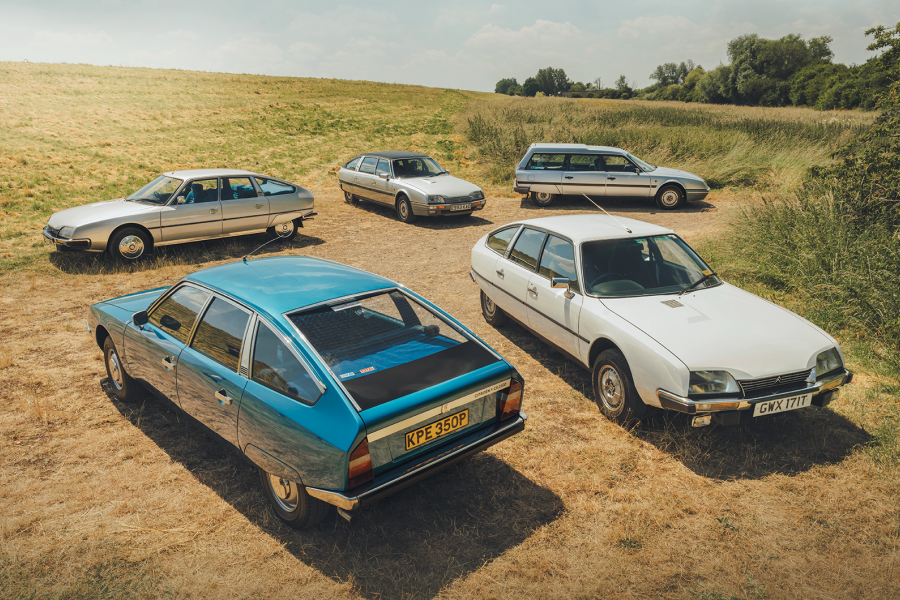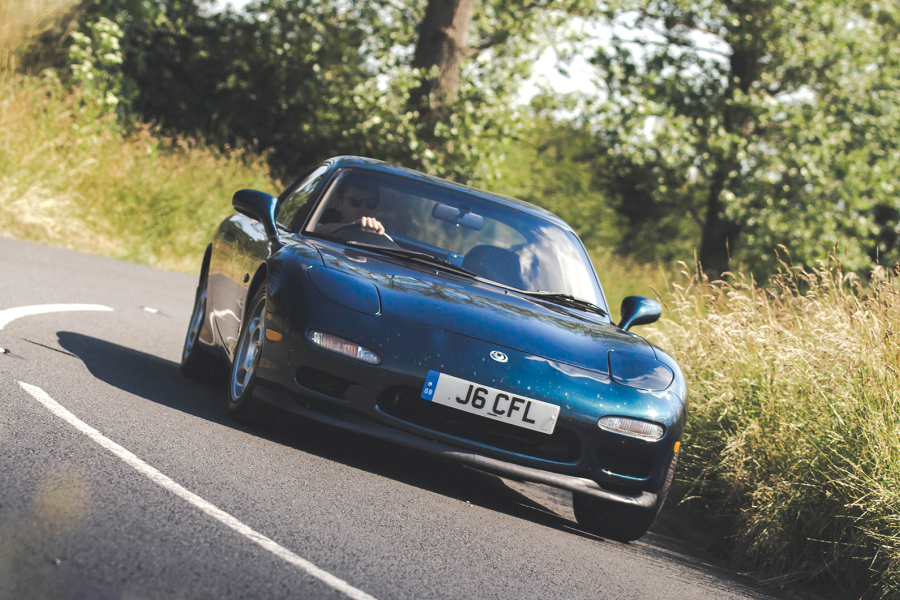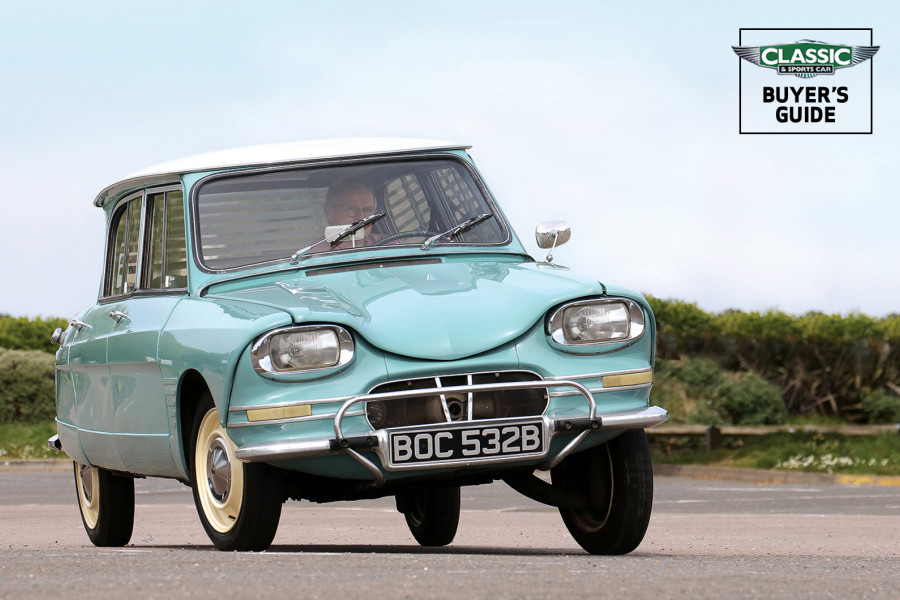The second owner brought the Birotor to the UK. When a Citroën specialist, stumped by the rotary engine, failed to get it running for him Blake was called in and he had the Birotor fired up within half an hour. Naturally it was love at first sight, and in April 2018 Mr Philip Blake became its first registered keeper.
Sitting higher, on taller wheels with fatter tyres, it looks subtly more aggressive than a regular flat-four GS. Its two-box profile suggests a hatchback, when all you get is a normal bootlid.
Quirky GS has a single-spoke wheel
Just as most 110S Cosmos are white, most Birotors seem to be chocolate brown or light gold with a contrasting roof finish.
The brown theme continues inside where, to justify a price-tag that was 70% higher than the most expensive air-cooled GS, Citroën gave the Birotor full carpeting, circular instruments and front seats with built-in headrests.
On the centre console there’s a button and a gauge to monitor engine oil levels, a reminder that rotary oil consumption is much higher than with a piston engine.
Like NSU, Citroën adopted a semi-automatic three-speed gearbox for the Birotor to mask the lack of low-speed torque and overrun snatch. Known as the C-Matic (in Citroën speak), it demands that you time your changes carefully until you have acclimatised: generally smooth, it won’t be rushed. On the other hand, second is a useful all-purpose 80mph gear so you don’t have to use it all that much, even in town driving.
Chocolate brown seems the default choice
The C-Matic doesn’t compromise the feel of the car, which is smooth and lively, happier the harder it is extended and always with that feeling of smooth unburstabilty as the revs keep coming. Certainly no other GS had anything like this car’s urge, and with its anti-roll bars and that smaller, lighter engine there is less roll, understeer and tyre squeal to contend with.
Chasing Blake in the Ro80 back to his rural rotary compound, the Birotor easily keeps station with the German car, floating serenely along on its hydropneumatics like any other GS.
To have such an isolating big-car ride in something so compact was one of the great features of these flat-four Citroëns, and the Birotor would end up being the one and only production car to mix hydropneumatics and a Wankel engine.
Spartan NSU cabin
Blake’s green 1969 Ro80 is one of the first right-hookers, sold new to a British Army captain in Germany. He returned to the UK in 1973 and kept the car until he died in 2002, which was when Blake managed to capture it.
I still find the Ro80 beautiful, yet the austerely practical interior feels at odds with the dramatic exterior. But you grow to like its simple dash and pleasingly open floor area in front, which has minimal transmission-hump intrusion.
On the move it feels far quieter and more ‘executive’ than the others, unflappably competent yet far from just another bland Teutonic saloon. The body roll appears much more alarming from outside than it feels from within, and it rides, grips and stops beautifully on those skinnily shod Fuchs alloy wheels.
The long suspension travel makes a mockery of road humps and the strong brakes are much easier to modulate than the highly powered type fitted to the Citroën.
Name is derived from its internal designation, Typ 80, which was already taken by Mercedes
The Ro80 is happy to wind around on twisty roads, but it is at its best when striding out on to long, straight, high-speed routes where it can hold its momentum for hours on end in a state of total stability. This is what the car was all about, and why it was the true and natural home for the Wankel rotary engine.
With four spark plugs, four circular lights and vinyl seats, this car is typical of the ‘Mk1’ Ro80s. It has done just 76,000 miles, many of the past 10,000 on trips to European NSU meetings. Blake is not shy of going any distance in these supposedly ‘unreliable’ cars and, while by no means blind to their faults, remains an evangelist for the Ro80 cause, committed to getting more of them into the hands of people who will appreciate one of the great cars of the ’60s.
Of his many Ro80s, four are currently on the road and two are for spares, but the rest are eminently restorable prospects. If you speak to him nicely he might sell you one, or even restore it for you. As for the Mazda Cosmo and the Citroën Birotor? They’re going nowhere, so don’t even bother asking.
Images: John Bradshaw
FACTFILES
MAZDA COSMO 110S
- Sold/no built 1967-’72/1206 (including pre-production cars)
- Construction steel monocoque
- Engine two-rotor 982cc Wankel, with twin spark plugs per chamber and Hitachi-Stromberg four-barrel carburettor
- Max power 110bhp @ 7000rpm
- Max torque 96Ib ft @ 3500rpm
- Transmission four-speed manual, RWD
- Suspension: front independent, by wishbones, coil springs, anti-roll bar rear de Dion axle, trailing arms, semi-elliptic leaf springs; telescopics f/r
- Steering rack and pinion
- Brakes discs front, drums rear (with servo from 1968)
- Length 13ft 51/2in (4102mm)
- Width 5ft 21/4in (1581mm)
- Height 3ft 91/2in (1156mm)
- Wheelbase 7ft 2in (2184mm)
- Weight 2111lb (958kg)
- 0-60mph 10.2 secs
- Top speed 116mph
- Mpg 18-21
- Price new £2607
- Price now £100,000
CITROËN GS BIROTOR
- Sold/no built 1973-’75/847
- Construction steel monocoque
- Engine iron-block, two-rotor 995cc Wankel, with two Solex carburettors
- Max power 107bhp @ 6500rpm
- Max torque 101Ib ft @ 3000rpm
- Transmission three-speed semi-auto, FWD
- Suspension independent, at front by wishbones rear trailing arms; hydropneumatic self-levelling f/r
- Steering rack and pinion
- Brakes powered discs
- Length 13ft 61/4in (4120mm)
- Width 5ft 43/4 in (1644mm)
- Height 4ft 6in (1370mm)
- Wheelbase 8ft 31/4in (2522mm)
- Weight 2513Ib (1140kg)
- 0-60mph 13.3 secs
- Top speed 109mph
- Mpg 20-22
- Price new £3000
- Price now £30,000
NSU Ro80
- Sold/no built 1967-’77/37,402
- Construction steel monocoque
- Engine iron-block, two-rotor 995cc Wankel, with two twin-choke Solex carburettors
- Max power 113.5bhp @ 5500rpm
- Max torque 117lb ft @ 4500rpm
- Transmission three-speed semi-auto with torque converter, FWD
- Suspension independent, at front by MacPherson struts, anti-roll bar rear semi-trailing arms, coil springs, telescopic dampers
- Steering ZF power-assisted rack and pinion
- Brakes discs, with servo
- Length 15ft 81/4in (4782mm)
- Width 5ft 93/4in (1772mm)
- Height 4ft 8in (1422mm)
- Wheelbase 9ft 41/2in (2858mm)
- Weight 2632lb (1196kg)
- 0-60mph 12.6 secs
- Top speed 112mph
- Mpg 16-20
- Price new £2444 (1970)
- Price now £5-12,500
READ MORE
20 groundbreaking cars from Citroën’s first 100 years
Is the NSU Ro80 the greatest saloon ever made?
Remembering the Mazda Cosmo: a coupé for the space age
Martin Buckley
Senior Contributor, Classic & Sports Car





















